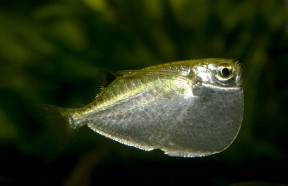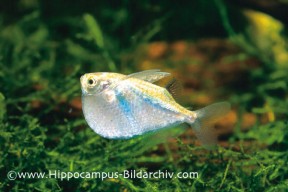Thoracocharax stellatus
Spotfin Hatchetfish
SynonymsTop ↑
Gastropelecus stellatus Kner, 1858
Etymology
Thoracocharax: derived from the Greek θώραξ (thṓraks), meaning ‘breastplate, cuirass’, and the generic name Charax, type genus of the Order Characiformes, itself derived from the Ancient Greek χάραξ (chárax), meaning ‘a palisade of pointed sticks’, in reference to the densely packed sharp teeth.
stellatus: Latin for starry or set with stars, a reference to the “platinum” shiny appearance.
Classification
Order: Characiformes Family: Gasteropelecidae
Distribution
The most widespread of all neotropical hatchetfishes; it has been recorded throughout much of South America including Venezuela, Colombia, Ecuador, Brazil, Peru, Bolivia, Paraguay, and Argentina.
It is thus considered to occur in several major river systems including the Orinoco, Amazon, and Paraná, plus many of their tributaries.
Type locality is ‘Rio Cuiaba, Brazil’, which corresponds to the rio Cuiabá, an affluent within the upper rio Paraguai basin in Mato Grosso state, Brazil.
Habitat
Has been recorded in both black and clear water streams, tributaries, backwaters, oxbows, and inundated floodplains. Most often found in areas with an abundance of surface vegetation.
Maximum Standard Length
60 – 70 mm.
Aquarium SizeTop ↑
An aquarium with surface dimensions of 120 ∗ 45 cm or equivalent should be the smallest considered.
Maintenance
Cover a good portion of the water surface with floating plants, which will help to make this flighty species less skittish. It seems to enjoy a bit of current to swim against occasionally but some quiet areas should also be provided.
Other décor is not particularly critical, but it looks good in both heavily planted setups and Amazon biotope-style tanks, with driftwood branches, a sand substrate and leaf litter. Make sure that the cover is very tightly fitting, since it is capable of clearing several metres in a single jump.
Unlike relatives from genera such as Carnegiella, Thoracocharax species tend to descend from the surface and spend time in the upper third of the water column, motionless or actively interacting within the species group.
Water Conditions
Temperature: 20 – 28 °C
pH: 5.0 – 7.5
Hardness: 18 – 215 ppm
Diet
Remaining close to the shore, it feeds primarily on insects; a study (Netto-Ferreira et al, 2007) determined that 99.6% of the diet of this fish consists of insects, and the majority (87.6%) of these were terrestrial.
Sometimes a little reluctant to take dried foods initially, but it will usually learn to accept them over time. A large proportion of the diet should consist of frozen and live foods, such as bloodworm and daphnia. Gut-loaded Drosophila fruit flies make an excellent food if they are available. This fish feeds from the surface but also readily descends to snap up sinking foods.
Behaviour and CompatibilityTop ↑
Very peaceful but it can be nervous, and will not compete well with boisterous species for food. Good tankmates include other fish that inhabit different parts of the tank, such as tetras, bottom-feeding cichlids like Geophagus or Satanoperca sp., and catfish such as Corydoras and Loricariids. Always buy at least half a dozen, as it won’t settle without the security of conspecifics.
Sexual Dimorphism
Females are noticeably rounder-bodied than males when full of eggs.
Reproduction
Unrecorded.
NotesTop ↑
T. stellatus is superficially similar to its only congener T. securis, but can immediately be identified by the presence (vs. absence) of a prominent dark spot in the dorsal-fin. It is sometimes traded as ‘platinum hatchetfish’.
The genus Thoracocharax was originally erected by Fowler in 1906 as a subgenus of Gasteropelecus, but was elevated to generic status by Weitzman in 1960 for the subject species and T. securis.
The family Gasteropelecidae is separated from other Characiformes by the following combination of characters: frontal bone longitudinally corrugated with a strong longitudinal ridge; posttemporal and supracleithrum fused into a single bone; pelvic fins and associated bones minute; presence of an enlarged, strongly convex muscular pectoral girdle region, consisting of greatly expanded coracoids fused to a single fan-shaped and corrugated median bone; lateral line extending ventro-posteriorly to approach the anal-fin insertion; 0-2 or 3 scales behind head and one or very few scales on caudal-fin base; 10-17 dorsal-fin rays; 22-44 anal-fin rays; adipose-fin present in larger species (those in Gasteropelecus and Thoracocharax), absent in smaller species (those in Carnegiella).
Gasteropelecids are commonly-referred to as ‘freshwater hatchetfishes’ due to their heavily-keeled body shape which has evolved in such a way due to possessing an enlarged, heavily-muscled pectoral girdle, and which resembles the shape of a hatchet head.
They are sometimes said to be capable of propelled flight above the water surface by beating their pectoral fins but in fact this is not the case and was disproven by Wiest (1995) who used high speed video photography to demonstrate that the pectoral fins are used in leaving the water but not while the fish is in the air. The action is more accurately described as a powerful jump and is actually a modified threat response which only appears to be used in extreme circumstances much like in many other fishes.
The researcher also found that the fish only seem to be able to jump once or twice before requiring a rest period due to the large amount of energy required to work the massive pectoral girdle muscles, and when fatigued their threat response is comparable to that of other small species in that they dive towards the substrate.
In addition anecdotal evidence from fish collectors and icthyologists working in the field would suggest that gasteropelecids rarely jump and they also tend not to do so in aquaria, even when being chased with a net (pers. obv.). However, leaving the tank cover open during darkness is likely to result in one or more hatchetfish on the floor by morning, so clearly they can and will jump.
The family Gasteropelecidae contains three genera. Thoracocharax, the most primitive and distinguished by its impressive keel, contains two species, T. securis and T. stellatus. Gasteropelecus contains three species, G. sternicla, G. levis and G. maculatus. These two genera contain the largest in size of the hatchetfish, and all are silver in colouration; G. sternicla is the more frequently seen of these five species, though any of them may be offered as “Silver Hatchetfish.” The third genus, Carnegiella, contains four described species that are the most derived or specialized of the hatchetfishes, and all are smaller and lack an adipose fin.
The genus Thoracocharax is the most widespread of the hatchetfishes and the two species have distinct chromosomal and morphological characteristics in different geographic regions. Thoracocharax stellatus presents a considerable morphological polymorphism among populations, mainly due to the geographic isolation (Silva et al, 2012). This type of diversity may sometimes lead to subspecies or distinct species within the complex. Phylogenetic analysis by Kelly T. Abe et al. (2013) determined that this species is in a monophyletic lineage, but there were four well-supported clades found among the samples, “separated by relatively large genetic distances and following a well defined geographic orientation,” suggesting that “T. stellatus may represent a species complex instead of a single species.”
Characiformes is among the most diverse orders of freshwater fishes currently including close to 2000 valid species distributed among 19 families. This tremendous taxonomical and morphological diversity has historically impaired the ability of researchers to resolve their genetic relationships with many genera remaining incertae sedis. A further limiting factor has been that in many cases exhaustive study of these on an individual basis is the only way to resolve such problems. Modern molecular phylogenetic techniques have allowed some headway, though, and research papers by Javonillo et al. and Oliveira et al., published in 2010 and 2011, respectively, revealed some interesting hypotheses.
The results of the former suggest that Gasteropelecidae forms a monophyletic clade nested within the family Characidae, while the latter expanded on this and concluded that within the family Carnegiella is the sister group of Gasteropelecus with Thoracocharax sister to that clade, and that Gasteropelecidae appears most closely-related to the authors’ expanded Bryconidae which contains the genera Brycon, HenochilusandSalminus.
Others such as Oliveira et al. (2011) have concluded that the family Erythrinidae is also closely-related to this grouping with Hepsetidae and Alestidae more distant.
References
- Kner, R., 1858 - Sitzungsberichte der Kaiserlichen Akademie der Wissenschaften. Mathematisch-Naturwissenschaftliche Classe v. 32 (no. 22): 163-168
Zur Familie der Characinen - Abe, Kelly T., Tatiane C. Mariguela, Gleisy S. Avelino, Ricardo M.C. Castro, and Claudio Oliveira, 2013 - Molecular Phylogenetics and Evolution 69: 1209-1214
Multilocus molecular phylogeny of Gasteropelecidae (Ostariophysi: Characiformes) reveals the existence of an unsuspected diversity - Javonillo, R., L. R. Malabarba, S. H. Weitzman and J. R. Burns, 2010 - Molecular Phylogenetics and Evolution 54(2): 498-511
Relationships among major lineages of characid fishes (Teleostei: Ostariophysi: Characiformes), based on molecular sequence data - Netto-Ferreira, Andre L., Miriam P. Albrecht, JorgeL. Nessimian and Erica P. Caramaschi , 2007 - Neotropical Ichthyology 5(1): 69-74
Feeding Habits of Thoracocharax stellatus (Characiformes: Gasteropelecidae) in the upper Rio Tocantins, Brazil - Oliveira, O., G. S Avelino, K. T. Abe, T. C Mariguela, R.C Benine, G. Ortí, R. P. Vari and R. M. Corrêa e Castro, 2011 - BMC Evolutionary Biology 11: 275-300
Phylogenetic relationships within the speciose family Characidae (Teleostei: Ostariophysi: Characiformes) based on multilocus analysis and extensive ingroup sampling - Silva, Edson Lourenco da, Rafael Splendore de Borba, Liano Centofante, Carlos Suetoshi Miyazawa, and Patricia Pasquali Parise-Maltempi, 2012 - Comparative Cytogenetics 6(3): 323-333
Cytogenetic analysis in Thoracocharax stellatus (Kner, 1858) (Characiformes, Gasteropelecidae) from Paraguay River Basin, Mato Grosso, Brazil - Weitzman, S. H., 1960 - Stanford Ichthyological Bulletin 7(4): 217-239
Further notes on the relationships and classification of the South American characid fishes of the subfamily Gasteropelecinae. - Weitzman, Stanley H. and Lisa Palmer , 1996 - Tropical Fish Hobbyist, September 1996: 195-206
Do Freshwater Hatchetfishes Really Fly - Wiest, F.C., 1995 - Journal of Zoology 236 (4): 571-592
The specialized locomotory apparatus of the freshwater hatchetfish family Gasteropelecidae




